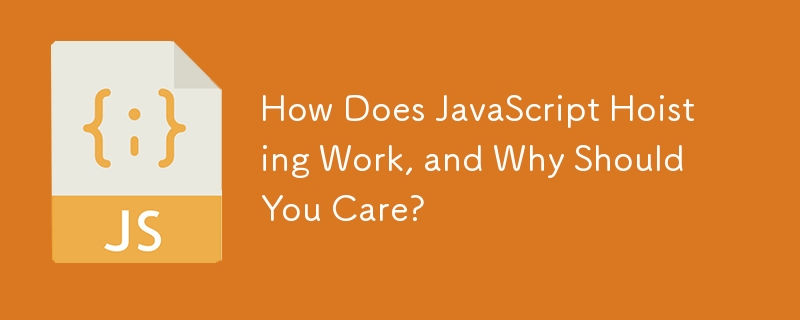How Does JavaScript Hoisting Work, and Why Should You Care?
Nov 02, 2024 am 09:26 AM
Understanding Hoisting in JavaScript
When dealing with variables in JavaScript, it's essential to grasp the concept of hoisting. Hoisting is a phenomenon where variables are automatically moved to the top of their scope, regardless of where they are declared.
Variable Hoisting in Global Scope
In the provided code:
1 2 3 |
|
Hoisting applies to variables declared outside of functions. In this case, myVar1 is declared in the global scope. Therefore, when the code is executed, it is interpreted as follows:
1 2 3 |
|
Notably, the execution proceeds even though the return statement appears before the variable declaration. This behavior is attributed to hoisting, which brings the variable declaration to the top of the scope.
Browser Compatibility Issues
While hoisting works as expected in Safari and Chrome, older browsers like IE, Firefox, and Opera throw errors. This is because these browsers require the return statement to be placed after all variable declarations in the function.
Best Practices
To avoid browser compatibility issues and prevent unintended consequences of hoisting, it is recommended to declare variables at the beginning of their scope. This ensures that hoisting does not create any problems. Additionally, tools like JSLint can help identify and flag hoisting-related issues in your code.
True Hoisting Example
A true example of hoisting can be observed in the following code:
1 2 3 4 5 6 7 8 |
|
Here, the initial declaration of foo is hoisted to the top of the scope, but within the bar function, a new variable with the same name is declared. Since hoisting only applies to declarations, the second foo variable overrides the first one. As a result, the alert will display "10."
Conclusion
Understanding hoisting is critical for writing clean and efficient JavaScript code. While hoisting can be a useful feature, it is essential to be aware of potential browser compatibility issues. By following best practices and declaring variables at the top of their scope, developers can avoid hoisting-related problems and ensure code runs as intended across different browsers.
The above is the detailed content of How Does JavaScript Hoisting Work, and Why Should You Care?. For more information, please follow other related articles on the PHP Chinese website!

Hot Article

Hot tools Tags

Hot Article

Hot Article Tags

Notepad++7.3.1
Easy-to-use and free code editor

SublimeText3 Chinese version
Chinese version, very easy to use

Zend Studio 13.0.1
Powerful PHP integrated development environment

Dreamweaver CS6
Visual web development tools

SublimeText3 Mac version
God-level code editing software (SublimeText3)

Hot Topics
 Replace String Characters in JavaScript
Mar 11, 2025 am 12:07 AM
Replace String Characters in JavaScript
Mar 11, 2025 am 12:07 AM
Replace String Characters in JavaScript
 Custom Google Search API Setup Tutorial
Mar 04, 2025 am 01:06 AM
Custom Google Search API Setup Tutorial
Mar 04, 2025 am 01:06 AM
Custom Google Search API Setup Tutorial
 8 Stunning jQuery Page Layout Plugins
Mar 06, 2025 am 12:48 AM
8 Stunning jQuery Page Layout Plugins
Mar 06, 2025 am 12:48 AM
8 Stunning jQuery Page Layout Plugins
 Improve Your jQuery Knowledge with the Source Viewer
Mar 05, 2025 am 12:54 AM
Improve Your jQuery Knowledge with the Source Viewer
Mar 05, 2025 am 12:54 AM
Improve Your jQuery Knowledge with the Source Viewer
 10 Mobile Cheat Sheets for Mobile Development
Mar 05, 2025 am 12:43 AM
10 Mobile Cheat Sheets for Mobile Development
Mar 05, 2025 am 12:43 AM
10 Mobile Cheat Sheets for Mobile Development









